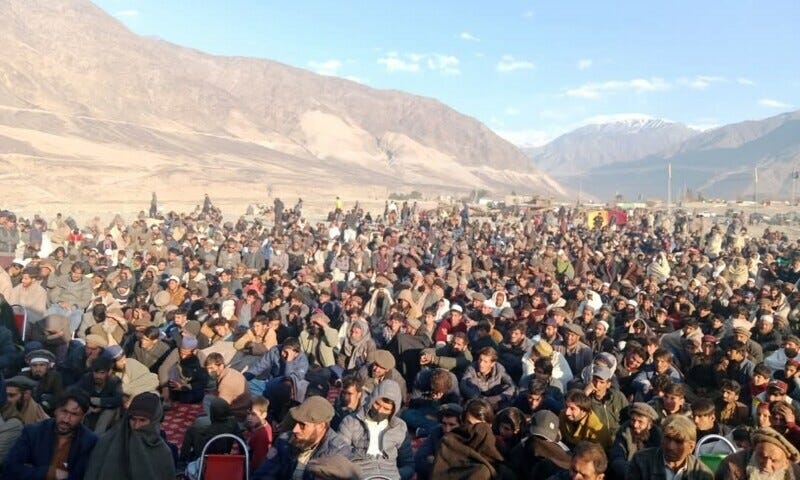Diamer-Bhasha Dam Protests
A Struggle for Rights in Gilgit-Baltistan
The ongoing protests in Gilgit-Baltistan's Diamer district have once again spotlighted the long-standing grievances of the region's residents over the Diamer-Bhasha Dam project. Thousands of protesters, primarily affected by the project, have staged a sit-in at Chilas for over a week, demanding that the government fulfill a 31-point charter outlining their rights, including compensation, employment, and infrastructure development. Despite reassurances from Islamabad, locals remain skeptical, citing years of unfulfilled promises and systemic neglect.
Historical Context and the Diamer-Bhasha Dam
The Diamer-Bhasha Dam, a mega-hydropower project on the Indus River, has been planned for decades as a means to enhance Pakistan’s energy capacity and water storage. With a projected cost exceeding $14 billion, it is expected to generate 4,500 megawatts of electricity and store 8.1 million acre-feet of water. The government hails it as a game-changer for Pakistan’s energy crisis, but for the people of Gilgit-Baltistan (GB), it represents a forced displacement and a struggle for their rightful share of benefits.
The dam’s construction requires large-scale land acquisitions, which have led to the displacement of thousands of local families, primarily from the Diamer district. While compensation packages were announced, many residents claim that the amounts are insufficient and that the distribution process is riddled with corruption and bureaucratic inefficiencies. The 31-point demand list includes provisions for adequate compensation, employment for locals in dam-related projects, free or subsidized electricity, and educational and health facilities.
Current Protests and Government Response
The latest protests erupted in February 2025, with demonstrators vowing to block further dam construction unless their demands are met. The movement has gained significant momentum, with support from various tribes, political parties, religious organizations, and civil society groups. Protest leaders, such as Maulana Hazratullah, have accused the federal government of exploiting the region’s resources while ignoring the rights of its people.
In response, Prime Minister Shehbaz Sharif formed a federal committee led by Minister for Kashmir Affairs and Gilgit-Baltistan, Amir Muqam. The committee held its first meeting in Islamabad, with representatives from the Ministry of Water Resources, GB’s Chief Minister Haji Gulbar Khan, and officials from the Water and Power Development Authority (WAPDA) participating. The government reiterated its commitment to addressing legitimate grievances and expediting compensation payments and development projects in affected areas. However, many locals view these statements as mere rhetoric, given past inaction.
Gilgit-Baltistan’s Marginalization and Constitutional Limbo
Beyond the immediate concerns surrounding the dam, the protests reflect deeper issues related to GB’s political and economic marginalization. Gilgit-Baltistan, despite being an integral part of Pakistan’s strategic corridor, lacks provincial status and representation in the National Assembly and Senate. Its residents are subject to taxation without full constitutional rights, leading to widespread discontent.
The region has historically faced economic neglect, with limited investment in infrastructure, healthcare, and education. Development projects like the China-Pakistan Economic Corridor (CPEC) have brought little direct benefit to the local population, further fueling frustration. Additionally, laws such as the Anti-Terrorism Act have been used against activists and protestors, suppressing calls for greater autonomy and equitable resource distribution.
Implications for Pakistan’s Energy and Security Policy
The continued resistance against the Diamer-Bhasha Dam poses significant challenges for Pakistan’s energy policy. The project is critical to addressing the country’s power shortages and water management issues. However, failure to resolve local grievances could lead to prolonged disruptions and resistance, further delaying its completion.
Moreover, unrest in Gilgit-Baltistan could have broader geopolitical ramifications. The region is a key node in the CPEC, and sustained protests may impact Pakistan’s commitments to Chinese investors. Additionally, tensions in GB provide an opportunity for external actors to exploit local discontent, which could pose security risks.
The Path Forward
For the government to move forward effectively, it must take a participatory and transparent approach to address the concerns of the Diamer-Bhasha Dam-affected communities. Key steps include:
Ensuring Fair Compensation – Immediate and transparent disbursement of compensation to affected families, with mechanisms to prevent bureaucratic delays and corruption.
Employment and Development Initiatives – Prioritizing local hiring for dam-related jobs and investing in education and healthcare facilities.
Electricity and Royalties for GB – Granting GB a fair share of the dam’s royalties and ensuring free or subsidized electricity for residents.
Political Representation – Initiating meaningful discussions on granting GB provincial status or enhanced representation in decision-making bodies.
Dialogue with Protest Leaders – Engaging with local representatives to find mutually agreeable solutions and prevent future unrest.
Conclusion
The Diamer-Bhasha Dam protests are not merely about compensation; they highlight the broader struggle of Gilgit-Baltistan’s people for recognition, rights, and equitable development. As Pakistan moves forward with its ambitious infrastructure plans, it must ensure that local communities are genuine stakeholders in the process. Failure to do so could turn development projects into sources of enduring conflict rather than national progress.



